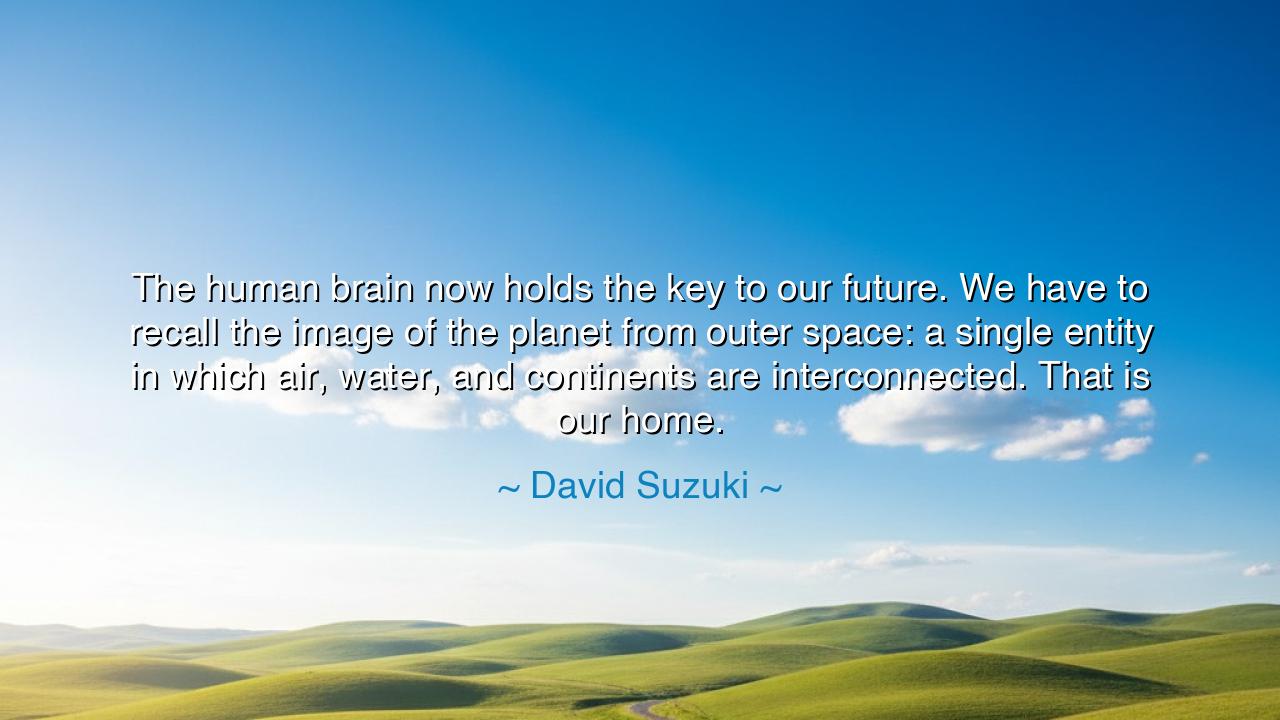
The human brain now holds the key to our future. We have to
The human brain now holds the key to our future. We have to recall the image of the planet from outer space: a single entity in which air, water, and continents are interconnected. That is our home.






In the grand course of history, there have always been moments when humanity’s understanding of its place in the world shifted dramatically. These moments of revelation, whether in science, philosophy, or art, have the power to reshape not only the way we see ourselves but also how we interact with the world around us. David Suzuki’s words, “The human brain now holds the key to our future. We have to recall the image of the planet from outer space: a single entity in which air, water, and continents are interconnected. That is our home,” resonate deeply with this ancient wisdom. Suzuki speaks of the interconnectedness of all things, reminding us that our future is not determined by isolated actions, but by our collective awareness and the decisions we make as one interconnected species on a shared planet.
The ancients understood this deep connection to the world and all living things. In Greek philosophy, Heraclitus taught that everything is in a state of constant change, and that all things are in a state of interconnection. He saw the universe not as a collection of separate objects, but as a living, breathing unity, much like Suzuki’s vision of Earth—a single, interconnected entity. This idea was also found in the Chinese Daoist philosophy, where Laozi spoke of the Dao—the underlying force that binds all things together. Laozi understood that the harmony of the world relies on the balance between its parts, and that humanity’s role was to live in harmony with nature. Just as Suzuki urges us to see the planet from space, both Heraclitus and Laozi sought to help us understand that all things—air, water, and earth—are part of one great whole.
Consider the Renaissance thinkers, who, through the lenses of their new sciences and art, sought to understand the interconnectedness of the universe. Leonardo da Vinci, for instance, not only studied human anatomy but also how the human body interacts with the larger natural world. In his sketches and studies, he saw the interconnectedness of all things—the way the human heart works in relation to the blood, the way the muscles function in sync with the bones, and the way the human spirit connects to the divine. This understanding of interdependence was not limited to the human body but extended to all of nature, foreshadowing Suzuki’s belief that the planet itself is a living system that we must honor and protect. Leonardo’s visionary insight was an early recognition of the idea that everything is linked, much like Suzuki’s call to see our world as an interconnected whole.
The **ancient Indigenous peoples of the Americas also held a similar view of the Earth as a sacred whole. They viewed nature as a web of relationships, where the land, water, air, and creatures all had their roles to play in maintaining the balance of life. This interconnectedness was not just philosophical but practical, guiding their way of life in harmony with the earth. Their practices, like sustainable agriculture, respect for the animals, and care for the land, were rooted in a deep understanding that disrupting one part of the system could cause ripple effects throughout the entire ecosystem. In many ways, Suzuki’s words echo this ancient wisdom, reminding us that humanity’s future is bound to the well-being of the planet and its systems, and that our very survival is dependent on understanding the interconnections within it.
In more recent times, the space explorations of the 20th century provided a literal and symbolic shift in how we see the planet. The iconic image of Earth as a small blue dot from space, captured by the Apollo missions, showed humanity that the Earth is not an isolated entity but a tiny fragile ball suspended in the vastness of the universe. This perspective transformed the way we thought about our place on the planet and in the cosmos. In the same way, Suzuki calls us to view Earth from space, understanding that its interconnectedness is more than a philosophical idea—it is a tangible truth that we must embrace if we are to ensure our collective survival. Just as the ancients had their mystical and philosophical ways of seeing the world as a whole, modern science has now confirmed this unity in our planet's existence.
The lesson we must learn from Suzuki’s quote is clear: the future of humanity depends on recognizing the interdependence of all things. We must see the Earth as a single entity, not as a collection of isolated nations, ecosystems, or individual actions. Every choice we make, from how we treat the environment to how we interact with others, is part of the larger system that sustains us. Our well-being and future depend on living in harmony with the world around us, just as the ancients knew that humanity's place in the world was not separate from nature but intertwined with it.
In your own life, consider the interconnectedness of your actions. How do your choices today impact the future of the world around you? Just as the ancients saw their place in the grand design of the universe, you too must recognize that every action you take, no matter how small, ripples out into the world. Live with a sense of responsibility to the whole, knowing that the Earth is not a separate entity, but a home that we share with every living thing. Just as Suzuki reminds us to see the planet as a unified whole, take action to live in balance and harmony, for the future depends on the present we shape together.






AAdministratorAdministrator
Welcome, honored guests. Please leave a comment, we will respond soon